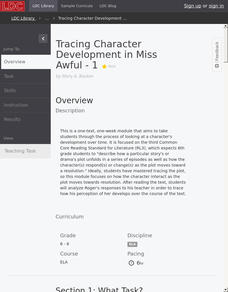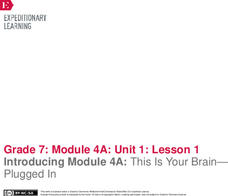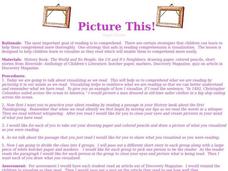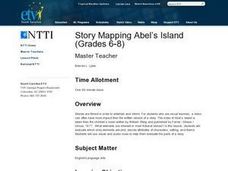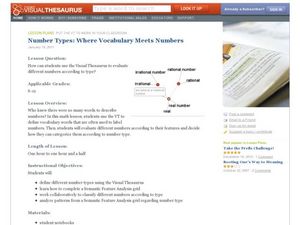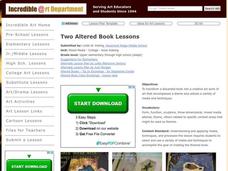Literacy Design Collaborative
Tracing Character Development in Miss Awful
Scholars take a close look at Roger in Miss Awful. As the plot develops, readers track Roger's perceptions of his substitute teacher. Learners then discuss how Roger's actions toward the substitute changes as the story progresses before...
EngageNY
Establishing Structures for Reading: Getting the Gist (Chapter 1)
Class members review expectations for successful discussions before reading chapter one of A Long Walk to Water by Linda Sue Park. They engage in a think-pair-share to discuss the gist of the text and add their thoughts to their Readers'...
EngageNY
End of Unit Assessment: Analyzing the Structure of Chávez’s Wrath of Grapes Speech
César Chávez gave his 1986 "Wrath of Grapes" speech to educate consumers about pesticide use. Scholars complete an end of unit 2 assessment, applying what they learned throughout the unit to a new text. They then analyze the structure of...
EngageNY
Introducing Module 4A: This Is Your Brain—Plugged In
What does brain science reveal about teens and decision making? Scholars watch a short video and participate in a gallery walk to pique their interest and curiosity about the topic. Next, they begin reading an informational article about...
EngageNY
Close Reading: Excerpt 2 of “The Digital Revolution and the Adolescent Brain Evolution”
Help scholars comprehend a challenging text. Using the resource, pupils read excerpts from an article about the digital revolution and adolescent brain development. As they read, they answer text-dependent questions and complete a close...
EngageNY
Forming a Research-Based Claim: Introducing Stakeholders and Consequences
Consequences, consequences. Using the resource, scholars engage in a class discussion about the repercussions of too much screen time. Next, they create a Cascading Consequences chart that lists the positive and negative effects of...
EngageNY
End of Unit 2 Assessment, Parts 1A and 1B: Fishbowl on Screen Time and Adolescents
Here's a surefire way to ensure that class discussions go swimmingly! Using the resource, scholars participate in a Fishbowl activity, forming two concentric circles in the classroom. As the group on the inside of the fishbowl discusses...
EngageNY
Qualities of a Strong Literary Essay
Put it all into words. Scholars work toward writing an argumentative essay. They begin by examining and marking strong words in Are We Medieval? A Literary Argument Essay Prompt. Learners then use Qualities of a Strong Literary Argument...
EngageNY
Making a Claim: Moon Shadow’s Point of View of the Immediate Aftermath
Body paragraphs are the building blocks of every essay. Pupils view and discuss a model essay using a rubric to evaluate one of its supporting paragraphs. Next, scholars use what they've learned to continue drafting their own literary...
EngageNY
The Five W’s
Let's take the big W. Scholars analyze the model newspaper article Sandy wreaks havoc across Northeast; at
least 11 dead and look to answer who, what, when, where, and why. They work in groups of three to complete a Five W’s web...
EngageNY
Organizing Research: The Inverted Pyramid
Bottom side up! Scholars complete an Inverted Pyramid handout to gain a better idea of how journalists organize information. They then look at the organization of a model newspaper article and gain ideas about creating their own...
Curated OER
Pictures Make Perfect!
Young scholars observe and demonstrate how to visualize the information they are reading. They participate in a visualization exercise, and discuss how visualizing information from the text can improve their comprehension. Students...
Curated OER
Picture This!
Students become fluent readers by assessing the strategy of visualization to visualize each event in a story. They use imagery to visualize all types of literature. Each student receives a copy of "Sideways Stories from Wayside School,"...
Curated OER
Picture This!
Students practice the strategy of visualization to aid in their reading comprehension of text. They paint mental pictures from readings from their history books, "The World and Its People: the US and It's Neighbors," and short stories...
Curated OER
Story Mapping Abel's Island
Students are able to prioritize story elements using graphic organizers. They are able to evaluate character, setting and sequence in a non-print source. Students use visual and audio clues to help them evaluate the parts of a story.
Curated OER
The Power of Words in "Charlotte's Web"
Students analyze the text in Charlotte's Web. In this language arts lesson, students dissect the passages from Charlotte's Web, specifically the adjectives Charlotte used to describe Wilbur. Finally, students play a game using "word...
Curated OER
Making Mind Movies
Students interact with the strategy of visualization to better understand what is happening in a story. They assess the poem, "Talented Family," and the book, "Sarah Plain and Tall," to visualize and imagine in their minds pictures of...
Curated OER
Using Oral Traditions to Improve Verbal and Listening Skills
Students examine the role of stories in African and African-American cultures. This lesson is written for students with visual impairments. They
Curated OER
Silent Symbols Speak Loudly: Icons, Brands & You
Young scholars view and discuss visual symbols around them every day, analyze symbols on United States one dollar bill, explore variety of meanings of same symbols depending on context and culture, and create their own money with symbols...
Curated OER
Pictures and Slogans Persuade an Audience!
Students understand that writers utilize various techniques to persuade an audience. They develop an awareness of how the media works to persuade them as the consumer. They create a visual representation of various feelings and emotions...
Learning to Give
Africa - The Great Southland
Applying the five themes of geography, preteen explorers develop a visual aid for younger learners in celebration African American History Month. They investigate the political, geographic, economic, and social aspects of the continent...
Curated OER
Number Types: Where Vocabulary Meets Numbers
Rational, irrational, real, natural. All these words can refer to numbers. Who knew? Learners use the Visual Thesaurus and a semantic feature analysis grid to examine the different attributes of numbers. Step-by-step instructions for...
Curated OER
How Media Shapes Perception
Young scholars explain the impact that the media may have in shaping their intellectual and emotional responses to current events. They examine broadcast and Web-based news sites to find subtexts through the use of language, audio, and...
Curated OER
Altered Books
Students transform a discarded book into a creative art work of art that encompasses a theme and utilizes a variety of media and techniques.
Other popular searches
- Visual Art Self Portrait
- Visual Art Lesson Plans
- Teacher Resources Visual Art
- Visual Art Lessons
- Visual Art Lessons Symmetry
- Visual Art Tessellations
- Visual Art and Culture
- Visual Art History
- Visual Art and Math
- Visual Art Self
- Visual Art & Science
- Visual Art Tesselations


